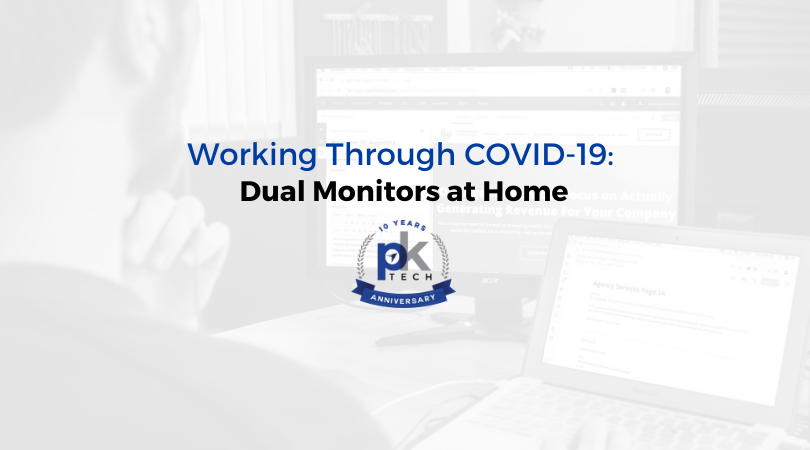What To Do If Your IT Guy Goes Out of Business Because of the Coronavirus
We’re hearing from our peers located in coastal cities first about early coronavirus-related effects on the IT industry. One IT-related topic is the...

Many of our clients and businesses in general are experiencing the transition into the WFH (work-from-home) model. We’re seeing the challenges first hand and therefore we’re making it our mission to share advice that can benefit any business dealing with the initial WFH inefficiencies.
First topic: dual monitors at home.
At your office, you may be accustomed to having two to three monitors. They can be mounted professionally and positioned ergonomically.
At home, you may be working with a small laptop screen or a single computer monitor. If you’re used to a more robust multi-monitor setup at work, this can be a huge efficiency drainer.
Here’s our guide below for connecting a second monitor at home. We’ll try to be as non-technical as possible, but please be warned, there’s a TON of different connector types and it will get a little nerdy.
Assessing your video output simply means we need to determine the ports on your computer that are capable of outputting a video signal. Because manufacturers love being difficult, there’s six different outputs we’ll talk about below.
These are the most common video outputs you’ll find on workstations and laptops below.

Common question: I can’t tell the difference between HDMI and DisplayPort. The answer is display port’s connector only has one flat edge, HDMI has two. HDMI is far more common on home-class computers.
These video outputs below are getting more common, and likely present if you have a new slim laptop.

You may have more than one video output option on your computer. However, you need to assess the monitor in step #2 and video cables in step #3 to choose the solution that works now. It’s hard to buy IT equipment right now. Laptops, monitors, and connectors are all in high demand. Ideally, you can connect the monitor you have the easiest access to now.
Take note what video outputs your computer has.
Assessing your monitor’s inputs simply means we need to determine what types of ports your monitor is equipped with that can receive video input. Look at the bottom of your monitor and find its inputs (it won’t mind).
Use the above pictures in #1 to determine what ports your monitor has. Most likely, your monitor will have: HDMI, DVI, and/or VGA. Below is the most common configuration, showing this monitor has three input types.

Take note what inputs your monitor has.
There are two types of “video cables”. The cable and the adapter. Most of the time, an adapter is not involved when connecting a monitor to a home-class computer. However, since some of our clients allowed staff to take a monitor from work, we’re covering this in case you wind up with an adapter.
Review the picture below to determine what types of cables you have.

Review the pictures below to determine if you have an adaptor.



IF YOU HAVE AN ADAPTER:
Determine if you even need it. If your computer only has a DisplayPort, Mini DisplayPort, or USB-C, you’ll need an adapter to convert it to HDMI, DVI, or VGA.
If you have HDMI, DVI, or VGA outputs on your computer, you won’t need the adapter for now.
Note down what types of cables you have.
It comes together here. We need to match output + input via a video cable.
The most common scenario is:
Depending on the video cable availability (you only want one video cable per monitor), use HDMI, DVI, then VGA in that order. VGA should be used as the last resort, as it is the oldest technology and has the worst video quality of the lot.
If you only have a Displayport, Mini Displayport, or USB-C connector on your computer, you’ll need an adapter to convert it into HDMI or DVI. Once it’s converted to HDMI or DVI, follow the above scenario for connecting to the monitor.
If you’re using HDMI, one thing that can happen is your sound may get sent to the monitor’s built in speakers, even if you already have speakers connected to your computer. You’ll have to go to Windows Settings->Sound and set it back to the speakers you were using before.
We hope the above information helps you. There are even more inputs, outputs, and ways to make USB ports into a video output. If you want to ask us a more detailed question about your options, and you’re trying to work from home, please reach out to us.
If you would like a quote or evaluation for IT services, don’t hesitate to reach out to PK Tech here: contact PK Tech.

We’re hearing from our peers located in coastal cities first about early coronavirus-related effects on the IT industry. One IT-related topic is the...

A Guide to Keeping Your Business Running During a Global Pandemic Health and well-being are of the utmost importance as we’re faced with an...

What’s the difference between your home and business class computer? Should they be the same? Different? And the most important question: why does it...